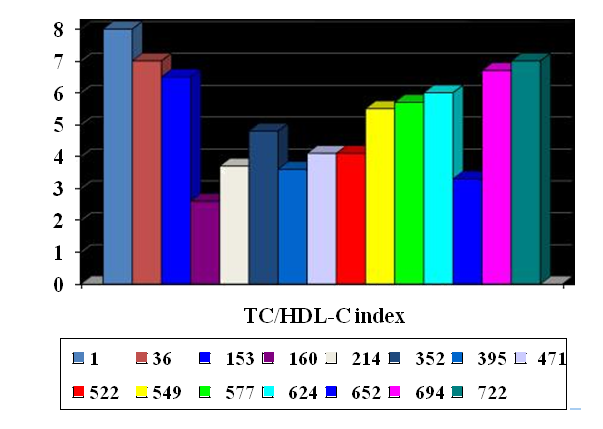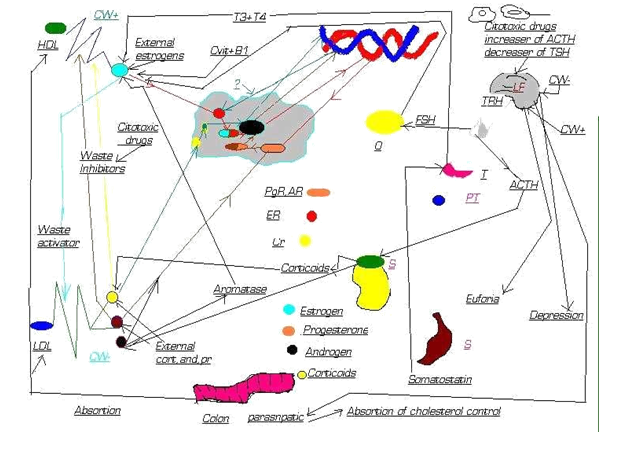Journal of
eISSN: 2373-633X


Research Article Volume 5 issue 4
Unt of Oncology Oncological Pinar del Rio, Cuba
Correspondence: Roberto L Lazo, Unt of Oncology Oncological Pinar del Rio, Cuba
Received: May 18, 2016 | Published: August 30, 2016
Citation: Lazo RL. The four-dimensional thought in cancer treatment. J Cancer Prev Curr Res. 2016;5(4):300-304. DOI: 10.15406/jcpcr.2016.05.00171
Introduction: Thinking about four-dimensions represents a new way of scientific focus in investigations; we are accustomed to the linear investigations that are in one direction, for example, the effect of causes in relation to a specific research. That, of course, is very important and expands the knowledge of the universe. In this paper we explain the importance of the four-dimensional thought as to the normal levels of total cholesterol and HDL cholesterol in time (according to age) expressed by the formula of cholesterol waste.
Material and methods: Two clinical records with metastatic breast cancer were analyzed at the Unit of Oncology of Pinar del Rio and graphics of follow up of the patients were performed regarding total cholesterol, HDL cholesterol, the total cholesterol/HDL cholesterol index and the application of the formula of cholesterol waste. A patient was selected with positive and another with negative cholesterol waste. Two other patients with brain metastasis were included, where different Computer Axial tomography and X-ray can be seen. One digital sheet that shows the follow-up of one of the patients with the formula of cholesterol waste is shown.
Results: We could see that the total cholesterol, the HDL cholesterol and the total cholesterol /HDL cholesterol index do not mean anything in the follow-up of the patients. However when we see the follow-up with the formula of cholesterol waste, we can identify one tumor as a high waste of cholesterol, and another as low waste of cholesterol, in the treatment we can see that tumors of high waste relapse when the waste becomes high waste and when it is maintained in low waste there is a response to the treatment; on the other hand, in tumors of low waste liver metastasis disappeared when a positive cholesterol waste was reached. On the other hand a patient is presented with brain, lung and bone metastasis that with an expectancy of life under one week could live three years. Another patient with brain metastasis is presented where the follow-up with the formula of cholesterol waste shows when it is all right and when relapse occurs. We conclude that we can increase survival in metastatic breast cancer when we apply the formula of cholesterol waste, trying to get the metabolic balance that is lost in breast cancer.
In the past century, Albert Einstein revolutionized physics with the theory of relativity. In radiotherapy treatment the system of planning in fourth dimension, bearing in mind the time of the respiratory movements, doing the best possible distribution of the dose and lesser damage at the normal tissues. Until now, we have used in clinical oncology a one-dimensional effect in clinical research. In this work we analyze the effect that the formula of cholesterol waste has digitally at the start of treatment and follow-up of two breast cancer patients, one with a negative and the other with a positive expenditure, to evaluate the usefulness of 4D clinical thinking. We also present two examples of what we can achieve in brain metastases from breast cancer.
The appearing of the formula of the waste of cholesterol in the year 2001 analyzed the connection between the total cholesterol and the HDL cholesterol according with the age in relation to relapse in breast cancer. In that formula the relation among estrogens receptors, estrogens and cholesterol was analyzed too. Total cholesterol spending for estrogen formation is inversely proportional to total cholesterol levels.1 Hence the first concept of cholesterol spending, the relation among estrogen, estrogen receptors and total cholesterol were analyzed. Two polar groups were taken there for the evaluation of the formula: 80% of premenopausal patients with a range of menarche-disease under 25 years were estrogen receptor negative, they had high estrogens levels and low total cholesterol, and secondly postmenopausal patients with an interval of menarche-menopause under 30 years: 80% of them were ER +, they had low serum estrogens and high total cholesterol.
For the construction of the formula the biological state of women was taken into account, according to age, and all of them were extrapolated to the normal levels of cholesterols in the women. In this way we did a mathematical calculation of the metabolic equilibrium according to age in relation to the waste of cholesterol for estrogen formation. This formula was conceived when it is applied in order that healthy women can have a zero result and It is necessary only to introduce in the program the date of birth and the levels of serum HDL cholesterol and total cholesterol. The formula gives the results of how many times the waste of cholesterol is increased or decreased in relation to the normal waste of cholesterol according to age. That way, in a woman that had an operation of breast cancer when she was 30 years old and had a follow-up for 5 years, the normal parameters of equilibrium change when she is 35 years old. All that means that metabolic equilibrium is relative. Also the cholesterol is not investigated as a carcinogen; it was investigated as a necessary factor for the formation of estrogens.
Moreover, there is an elasticity of the waste of cholesterol for the formation of estrogens of plus sign to minus sign in daily life within normal ranges; it has to do with nutrition, the patient's psychic status and includes sleep and wakefulness, all these parameters can change the metabolic equilibrium and when misbalance is so large the mechanism of programmed cell death and the immune system fail. It is for that reason that we must apply the formula of the waste of cholesterol in chemoprevention and in cancer treatment. In this work we analyze the effect that the formula of the waste of cholesterol has on the treatment of four patients with metastatic breast cancer and how the treatment with chemotherapy, hormone therapy and radiation therapy can be directed to obtain better therapeutic results.
Four medical histories were reviewed from the Oncological Unit of Pinar del Rio, Cuba for this study. Blood samples were taken from patients for the study of total cholesterol and HDL cholesterol before starting systemic treatments with chemotherapy or hormone therapy and during follow-up visits. Data were collected in automated Microsoft Excel office sheets, where all therapeutic data and analysis of interest are taken, such as date of operation, degree of differentiation and histology of the tumor, stage, metastatic nodes, estrogen receptor, progesterone, and herb-2. Clinical data were added in each consultation and cholesterol waste is automatically determined according to age and days of evolution after the operation.
Trying to simplify the understanding of the work, we chose only two patients with metastatic breast cancer for showing the movement of the waste of cholesterol. Two additional clinical records of patients with brain metastasis were reviewed with the respective presentation of X-rays. The digital sheet of the patient number four that shows the applied treatment and the movement of the waste of cholesterol can be seen.
As we can see in patient 1, its monitoring shown in Figure 1-4, for a period of 1532 days (4.1years), total cholesterol, HDL cholesterol, and total cholesterol / HDL cholesterol index do not reflect anything by themselves, but when we see the Figure 4, which represents the evolution of cholesterol waste, we observe that it is a tumor of high cholesterol waste; in its evolution we observed how the different treatment modalities interact in cholesterol spending, how this leads as close as possible to the spending level 0, which is the normal balance of cholesterols; there is a clear connection between relapses and monitoring of expenditure. Patient 2 is a patient who Meta stasized her liver in its evolution, she began to be monitored with cholesterols and as we can observe in Figure 5-7, total cholesterol, HDL cholesterol and total cholesterol / HDL cholesterol index did not reflect anything by themselves. However, when we looked at the spending cholesterol curve in Figure 8, we classified it as a low spending tumor. It can see that during treatment it gradually became possible to increase spending and when it came to near zero or positive spending the liver metastases disappeared ultrasonographycally, until the inefficiency of treatment made the patient’s relapse possible, which appears when cholesterol spending begins to fall back into negative. It is not the purpose of this paper to offer used therapeutic recommendations in these two patients, but we can say it is very useful to apply any available knowledge that increases or decreases cholesterol depending on whether it is a low or high spending tumor, till we reach our goal to achieve a zero balance represented by normal levels of total and HDL cholesterol according to age. This patient was monitored with liver metastases for a period of 769 days (2.1 years).

Figure 1 Shows the levels of total cholesterol (mmol/L) according to the different days of follow-up of the patient number 1.

Figure 2 We can see the movement of HDL cholesterol (mmol/L) during the follow-up of patient number 1.

Figure 3 Shows the movement of total cholesterol/HDL cholesterol index during the follow-up in patient number 1.

Figure 7 Shows the total cholesterol/HDL cholesterol index during the follow-up of patient number 2.
Application of the theory of the waste of cholesterol in patients with brain metastasis. We used the formula of the waste of cholesterol:
CW (cholesterol waste)
(Thyroid action)(Estrogens action)(HDL cholesterol) = (System A)
CW=------------------------------------------------------------------------------------------------
(Androgens)(Corticoids)(Progesterone)(LDL cholesterol)= (System B)
In healthy women a balance is necessary between System A and System B. When the misbalance is of system A because of excess of function, the breast tumors estrogen receptors appear negative, and with higher levels of estrogens are translated as tumors of high waste of cholesterol for estrogens formation and with increased levels of HDL cholesterol. Otherwise when the misbalance is because of an increase of the function of system B the tumors estrogen receptors appear positive, with lower levels of estrogens and HDL cholesterol with a lower waste of cholesterol for estrogen formation. These two systems that should stay in harmony may change with bad alimentary habits, stress, depression, toxic habits, the bad use of the hormones that conform both systems and other factors related to endocrine disorders. The endocrine aging of the woman is reflected in the balance of both systems, meaning that it is relative and related to age, that is how the waste of cholesterol is relative and it has to be considered in cancer treatment and chemoprevention. If we keep in mind what has been previously said, the treatment must be different in any moment of life, otherwise the monitoring with the formula of the waste of cholesterol is very important to know when the system is repaired by itself or another treatment is necessary.
Using cytotoxic drugs that cross the hemato-encephalic barrier, the schedule of chemotherapy with vinblastine and endoxan was indicated and helped with the use of corticoids and progesterone that are used together with radiotherapy seeking to reduce the waste of cholesterol when the patient is under radiotherapy treatment. In fact, the objective is to differentiate tumor cells for better response to radiotherapy. The use of corticoids and progesterone reduce the waste of cholesterol, which we can see in the written formula. These hormones are maintained in lower doses after the initial treatment to keep the balance of the waste of cholesterol.
For several years now, we have been applying the concepts of spending on brain metastases and the average life is 3 years. Radiographs [Figure 9-11] of the first patient treated in 2000 show lungs, bones and brain metastasis. It was a patient in a final stage, previously treated with chemotherapy, with adriamycin and Taxol schemes, and we found her in a semcomatose state, with oxygen for dyspnoea with status.
Performance ECOG 4 and a life expectancy shorter than a week, applying the concept balance on radiant treatment and chemohormonotherapy to seek balance. The patient could have her brain (cystic) metastasis operated on, recovered and lived for more than 3 years. The lack of pamidronate at that time was the cause of death because of hypercalcemia three years later. The application of this therapy in brain metastases is already customary in our center. An example of solid metastases can be seen in Figures 12 & 13 and the digital sheet of patient number 4: a patient that could live for more than 3 years and subsequently died of pericardial effusion, on chemo-hormone therapy the dose of steroid was monitored according to cholesterol expense. After chemo hormone-therapy and radiotherapy she was followed up in medical visits. Her hormone treatment was regulated according to the waste of cholesterol. As we can see in the digital sheet that has included the normal elasticity of the waste of cholesterol, she had maintained for three years a normal waste of cholesterol. She could live three years with excellent QoL and we can see that when the waste of cholesterol was wrong the patient was diagnosed with hypothyroidism and with pricardial effusion, finally she died but the last CAT of brain was negative. As we can see, survival with the use of the follow up of the waste of cholesterol formula can be increased and in the future we think that brain metastasis from breast cancer can be cured with better suggestions of treatment. The connection between the neuroendocrine system, cells, cholesterol and the waste of cholesterol for estrogen formation can be seen in Figure 14, and we can see how maintained depression, or maintained stress and other alterations of this complex system can change the waste of cholesterol, provoking immunogenic problems and endocrine misbalance, which can open the way for the development of cancer.

Figure 14 Shows the connection between positive waste of cholesterol and negative waste of cholesterol in relation to visceral organs, DNA, receptors, endocrine glands and steroid hormones, all of them with intervention in the endocrine metabolic balance. As we see the waste of cholesterol can be activated or inhibited for any element of this complex system and for that reason with a direct intervention in cells proliferation.
Four-dimensional thought in cancer medicine has the possibility to give a therapeutic leap forward in treating breast and other cancers. Even in advanced stages patients can be recovered that today we consider impossible to save with linear medicine. Moreover, the use of digital sheet speeds up 4d thought and enables us to take action when the balance is lost for any reason, which should be investigated by the medical oncologist and corrected from a dietary, drug or any other point of view. The application of palliative radiotherapy or with curative intent should be done when we can get the balance near zero when tumor cells tend to be most differentiated.2
From the results of this clinical observation study the application of these concepts is essential in a multi-institutional work to corroborate these results and apply them to all patients’ carriers of breast cancer regardless of clinical stage.
The spending formula in cholesterol allows us to analyze from a four- dimensial point of view the relation among lipoproteins carriers of cholesterol, it was created considering levels of normal cholesterols of women according to age, using math curves that take into account the different physiological states in women from youth to old age. In this case, age represents the 4th dimension, present in every moment of a woman’s life. Our research indicates one direct or indirect connection between estrogens formation and levels of HDL cholesterol, and in turn a ratio of LDL cholesterol with the formation of corticoids, progesterone and androgens, all with clinical application in the treatment and chemoprevention of breast cancer.3
The authors thank Dr Mohamed Amine Haireche for his kind help in assisting with the statistical analysis and proof reading of this study.
The authors declare no conflicts of interest.
None.

©2016 Lazo. This is an open access article distributed under the terms of the, which permits unrestricted use, distribution, and build upon your work non-commercially.
 Month of July is here, which is commonly known for the World Sarcoma month, the major aim of this program is to Educate people on early signs of Sarcoma and its diagnosis. To be part of this, we are doing our best to spread its awareness by accepting articles on this topic and grab best discount of 30% for your submissions to our Journal of Cancer Prevention & Current Research (JCPCR).
Month of July is here, which is commonly known for the World Sarcoma month, the major aim of this program is to Educate people on early signs of Sarcoma and its diagnosis. To be part of this, we are doing our best to spread its awareness by accepting articles on this topic and grab best discount of 30% for your submissions to our Journal of Cancer Prevention & Current Research (JCPCR).